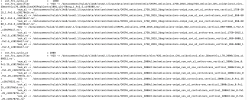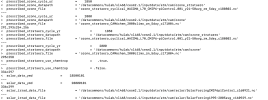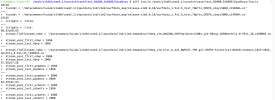Hi, I am a novice to CESM. I am using CESM2.1.0 and several problems were encountered.
First, I know that "Pre-industrial" means all the forcings (greenhouse gases, ozone, aerosols, etc.) are fixed at their 1850 values. So what is the meaning of 2000: present day? Is it the variables above fixed at their 2000 values? If so, what about HIST? Is it the variables values from historical real observations?
Second, since I want to conduct a simulation in 1850-2100, so which compsets should I choose? I checked out B1850, BHIST and BRCP85C5L45BGC compsets, and I found differences in their *_in file, such as atm_in and pop_in. In my opinion, I should use BHIST compset and set STON_N=250, STOP_OPTION=nyears and RUN_STARTDATE=1850-01-01. Do I need to download extra inputdata in addition to the files required by default for the BHIST compset?
Additionally, if there's something wrong with me, please tell me which compset should I choose and how to set env_run.xml.
Last is extra questions. If I want to change my simulation year to 1800-2100, I think I cannot use only one compset because I found BHIST inputdata is always started from 1850. So should I run the first 50 years with B1850 and then run from 1850 to 2100 utilizing the restart file before with BHIST compset? Again, I hope to correct my mistakes.
Sincerely hope to get your advice.
Best wishes!
First, I know that "Pre-industrial" means all the forcings (greenhouse gases, ozone, aerosols, etc.) are fixed at their 1850 values. So what is the meaning of 2000: present day? Is it the variables above fixed at their 2000 values? If so, what about HIST? Is it the variables values from historical real observations?
Second, since I want to conduct a simulation in 1850-2100, so which compsets should I choose? I checked out B1850, BHIST and BRCP85C5L45BGC compsets, and I found differences in their *_in file, such as atm_in and pop_in. In my opinion, I should use BHIST compset and set STON_N=250, STOP_OPTION=nyears and RUN_STARTDATE=1850-01-01. Do I need to download extra inputdata in addition to the files required by default for the BHIST compset?
Additionally, if there's something wrong with me, please tell me which compset should I choose and how to set env_run.xml.
Last is extra questions. If I want to change my simulation year to 1800-2100, I think I cannot use only one compset because I found BHIST inputdata is always started from 1850. So should I run the first 50 years with B1850 and then run from 1850 to 2100 utilizing the restart file before with BHIST compset? Again, I hope to correct my mistakes.
Sincerely hope to get your advice.
Best wishes!




